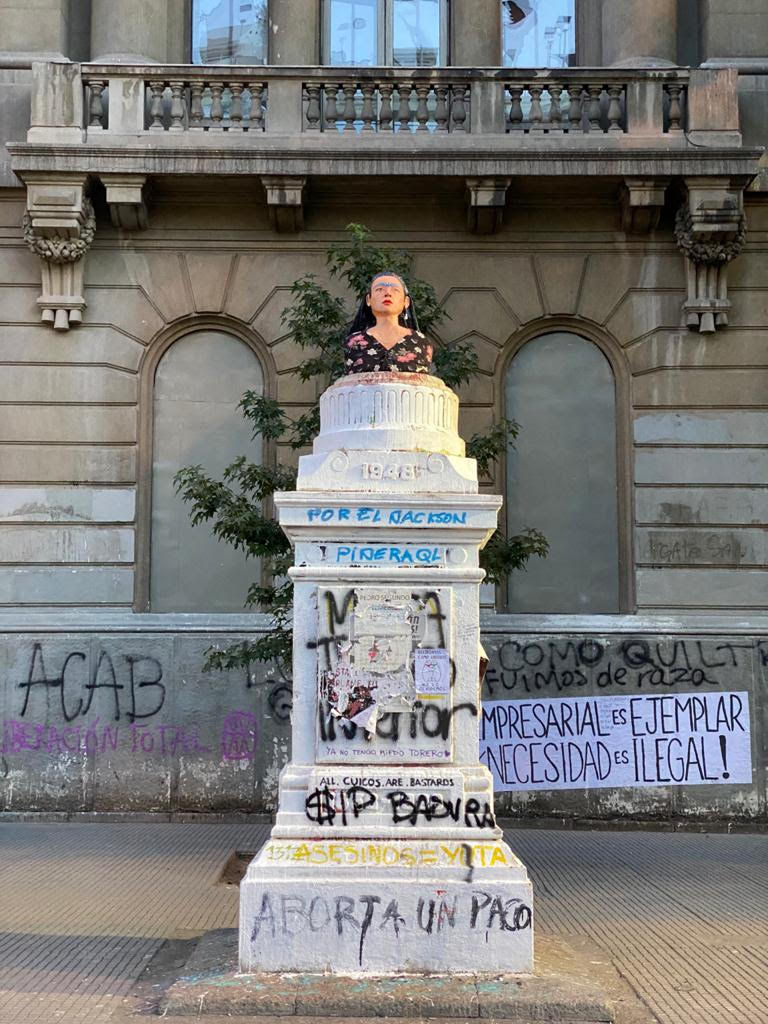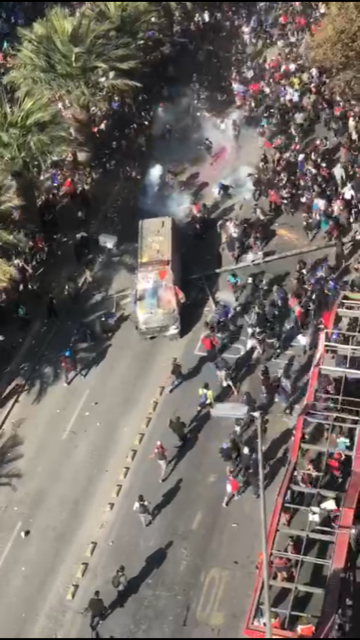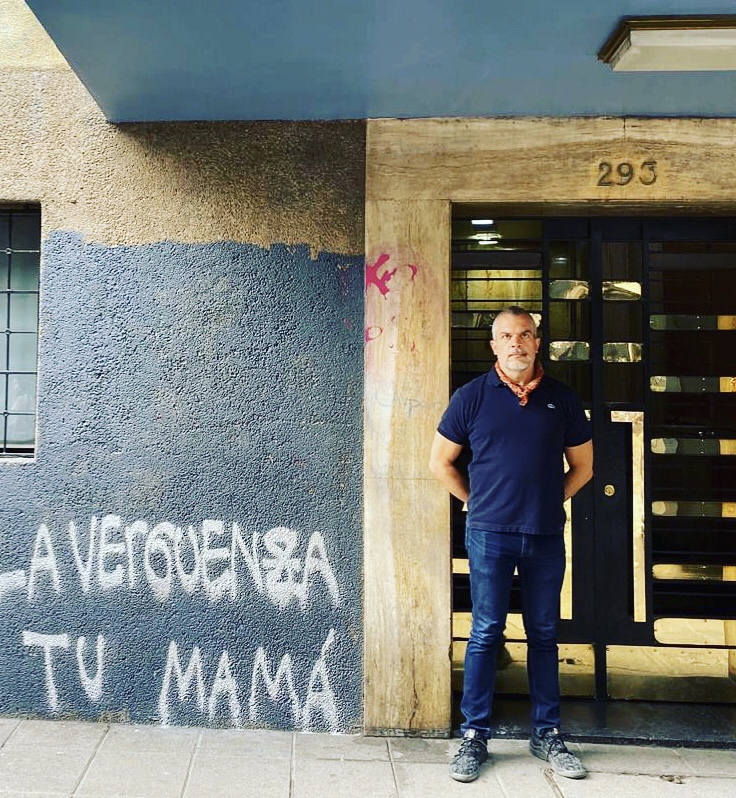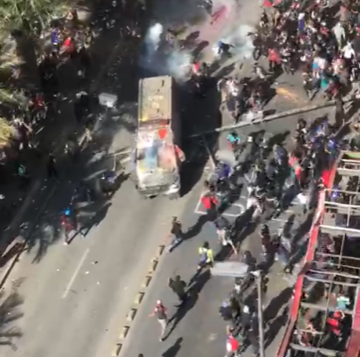
THIS PAST NOVEMBER, I found myself with some wonderment wandering through daily life in Santiago, Chile, in the midst of one of the largest populist uprisings in the world. I’d traveled there to attend a wedding and to visit one of my oldest friends, Ignacio Salas, a Chilean-born artist who grew up in the United States. I stayed steps from the Cerro Santa Lucia, the hill in the midst of the city center which was strategically captured by the Spanish conquistadors. Its fortification and weaponization was an assertion of dominance over the great valley of the Santiago Basin, and was used as a vantage point to plan the colonial city. In the present day, it is surrounded by rallying points for the daily protests: the Plaza Italia, the Parque Forrestal, the Lastarria section.
What sparked the protests, entering their third month at the time of this writing, was a proposed increase in the Santiago Metro fare of thirty pesos, the equivalent of five centsin U.S. currency. It was the straw that broke the camel’s back, coming after a period of increases in the costs of housing, water, food, electricity, banking, and telephony, and the protests spread throughout the country, notably to Concepción, San Antonio, Valparaiso, Iquique, and Rancagua. Initial actions defied the increase with mass fare evasions (as implored in graffiti: evade!) were conducted by school-age teens. This should give you an idea of how slim the margins are for the working class and poor, and how youth-driven this movement.
The government’s initial responses to the mass fare evasions were a declaration of a state of emergency, precipitating a deployment of military forces that led to deaths and human rights abuses, and the imposition of a curfew. This response only served to increase the scope of protests. More conciliatory gestures have followed: shake-ups to the cabinet, including the resignation of the minister of the interior, and some proposed reforms to education, health care, and pensions, the latest being a promise of long-sought constitutional reforms.

In Santiago, I was a rare American presence surrounded by marches, disruptions, actions, outrage, and confrontations with the militarized police force. The air was full of bitter smoke from the lacrimogenas, tear gas canisters that the police deployed with regularity. I was direct witness to these noxious deployments, but only heard about, with increasing horror, the police tactic of firing rubber bullets directly into the eyes of the protesters with the express intent of blinding them. I witnessed young women and men leading the marches and the actions, and the elderly cheering them on. The surrounding streets were set on fire nightly.
The city was covered in graffiti and paste-ups, creating an endless text, a city-as-text. The overlapping messages decry an unjust economic system (No es depresión, es capitalismo), denounce the current president, an elderly billionaire (Piñera Renuncia!), decry state violence (Estado Asasino!), demand a new constitutional assembly (the current constitution was authored under murderous dictatorship of General Pinochet), denounce injustices targeting indigenous peoples, denounce the culture of machismo (Paco homofobico!), and assert the dignity of their struggle. A vocal majority of the Chilean people back the broad demands for economic justice, human rights, political agency, and a reckoning on state violence past and present.
DURING MY VISIT, I found myself ruminating on a poem by the late Pedro Lemebel. It was my old friend Ignacio who’d introduced to his work. He had returned to live in Santiago in the grip of the optimism following the return to democracy in 1990, after the seventeen-year nightmare of Pinochet. Lemebel was a queer Chilean writer and activist who resisted homophobia, decried oppression, and subverted the culture of machismo during the dictatorship. He was unapologetically queer and spoke both to the people, through his Cronicas (“chronicles”) in newspapers and magazines, and to the powerful, delivering a biting critique of the state directly to an assembled group of officials in 1980 with a message of uplift for the poor, the working class, and all marginalized people.
Aside from the Cronicas, Lemebel’s output as a writer included poetry, short fiction, and one novel, Tengo miedo torero (“My Tender Matador”). His activism was performative. In collaboration with his friend Francisco Casas, he formed Las Yeguas del Apocalipsis (“The Mares of the Apocalypse,” a feminist subversion of the biblical Horsemen). Their guerrilla actions challenged ideals of masculinity and heteronormativity by confronting the political elite and the military regime, as well as their enablers in the Catholic Church. To deliver a poem, he once stormed a meeting of leftist parties to recite it in full drag, with a hammer and sickle painted on his face.
There are a couple of English translations available of that poem, titled “Manifiesto: Hablo Por Mi Diferencia”(“Manifesto: I speak for my Difference”). I found them stiff and formal, prompting me to undertake a close reading of the poem in the original Spanish, consulting with Ignacio on the historical references, the nuanced double entendres, and the use of Chilenismos (idiomatic phrasing specific to Chilean Spanish). While I was in Santiago, I made contact with Daniela Mardones, Lemebel’s niece and manager of his literary estate. She informed me that new English translations of this seminal poem are forthcoming.
Lemebel was born Pedro Mardones, but he took his mother’s surname in defiance of patriarchal naming customs.His marginalization as an effeminate, uneducated, poor person with indigenous roots from the slums of Santiago was complete, yet his physical and intellectual bravery was undeniable and compelling. In “Manifiesto,” he demands his dignity as a marginalized voice while decrying the abuses of the dictatorship (my translation follows):
Y yo no soy tan raro
Me apesta la injusticia.
Y sospecho de esta Cueca democrática
I’m not so strange
Injustice disgusts me
And I suspect this democratic dance
One of the historical references in the poem are the lines that rebuke one General Ibáñez, a homophobic and oppressive military dictator who ruled during formative periods in the 20th century, who created the very police force that’s committing human rights abuses today:
Como en el barco del general Ibáñez
Donde aprendimos a nadar
Pero ninguno llegó a la costa
Por eso Valparaíso apagó sus luces rojas
Por eso las casas de caramba
Le brindaron una lágrima negra
A los colizas comidos por las jaibas
Like General Ibáñez’ ship
Where we learned to swim
But no-one made it to shore
That’s why Valparaíso turned out its red lights
That’s why the houses of caramba
Shed a black tear
For the queens consumed by crabs
The section refers to a mournful episode in which homosexuals who were rounded up and imprisoned by Ibáñez were executed by way of fondeamiento, the practice of throwing detainees off of ships at sea with weights bound to their legs. The poem invokes the past abuses of the Chilean state to color the depth of Lemebel’s suffering at the hands of contemporaneous authoritarian rule.
Lemebel, who died in 2015, is frequently invoked as a mother of the current Chilean resistance movement, which sprung from that small increase in the metro fare and has grown into anintersectional movement, including demands from indigenous, feminist, queer, and environmental activist organizers. These demands, taken as a whole are Lemebelian in scope: an effective deconstruction of the patriarchal pact of oppressor church and colonizer state that brought the Chilean people to this despair. Among the miles of graffiti I saw were many paste-ups devoted to Lemebel, and a line from “Manifiesto” repeatedly scrawled on city walls as an encouragement to the resisters: Soy más subversivo que usted (“I am more subversive than you”).
The protesters are honoring Lemebel’s tactics when they throw their very bodies into the fray, when they endure repeated exposure to the poisons in the lacrimogenas, when masked cyclists take over public plazas to protect marchers from the police, when those at the front lines risk losing an eye from the rubber bullets, and when they face the cruelties of arrest and prosecution in their striving for freedom, justice, and accountability. Lemebel and his friend Casas once danced the cueca—Chile’s national dance—on broken glass during one performance, until their blood stained the map of Latin America they danced upon.
As Lemebel’s body of work becomes available in translation, we may expect him to be celebrated by the literary establishment for his defiantly queer personality, while his relevance as a voice of abjection, of poverty, of marginalization will be de-emphasized. Lemebel’s uncompromising bravery in the face of authoritarian oppression can inspire the resistance movement in the U.S., where we increasingly face many of the same threats to freedom and justice that Chileans have confronted.
 Dale Corvino’s short fiction and nonfiction have appeared in numerous journals, anthologies, and online, including The Rumpus and Salon. His chapbook Worker Names(Gertrude Press) was published in 2019.
Dale Corvino’s short fiction and nonfiction have appeared in numerous journals, anthologies, and online, including The Rumpus and Salon. His chapbook Worker Names(Gertrude Press) was published in 2019.






